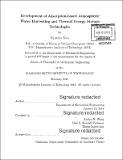| dc.contributor.advisor | Evelyn N. Wang. | en_US |
| dc.contributor.author | Kim, Hyunho, Ph. D. Massachusetts Institute of Technology | en_US |
| dc.contributor.other | Massachusetts Institute of Technology. Department of Mechanical Engineering. | en_US |
| dc.date.accessioned | 2018-05-23T16:32:19Z | |
| dc.date.available | 2018-05-23T16:32:19Z | |
| dc.date.copyright | 2018 | en_US |
| dc.date.issued | 2018 | en_US |
| dc.identifier.uri | http://hdl.handle.net/1721.1/115732 | |
| dc.description | Thesis: Ph. D., Massachusetts Institute of Technology, Department of Mechanical Engineering, 2018. | en_US |
| dc.description | Cataloged from PDF version of thesis. | en_US |
| dc.description | Includes bibliographical references (pages 139-146). | en_US |
| dc.description.abstract | Sorption-based energy technologies can be used to efficiently harvest fresh water from the atmosphere and to store thermal energy for climate control. Recent advances in porous adsorbents such as metal-organic frameworks (MOFs), with high sorption capacity and low regeneration temperature requirements, allow us to efficiently utilize them for these applications. However, detailed experimental and theoretical frameworks for the use of advanced sorbents have not considered several important aspects (e.g., inter/intracrystalline diffusion kinetics). This thesis provides a generalized framework to select the materials, design, and develop sorption-based energy and water systems. First, this thesis presents the design and demonstration of a device based on porous MOF-801 [Zr 6O4(OH) 4(fumarate)6] powered by natural sunlight (solar-thermal) that captures water from the atmosphere at ambient conditions, down to 20% RH. Under these conditions, operation of competing technologies, such as dew-based atmospheric water generators (AWGs), is infeasible. Laboratory experiments and computational simulations were used to optimize the device based on this MOF to maximize water delivery capacity in arid climates. We subsequently tested an optimized device in an exceptionally arid climate with 10-40% RH and sub-zero dew points. With a solar flux with 1.8x concentration for desorption, we demonstrated the operation of our device with a thermal efficiency ~14%. Finally, we quantitatively analyzed the water quality and showed that the MOF compound was stable to water, and the metal ions and organic linkers did not leach from the framework into the harvested water. Our demonstration indicates that passive operation of sorption-based AWGs with high efficiencies (> 20%) is possible and can be operated with abundant low-grade heat sources (~100°C) under exceptionally dry climates of RH < 40%. Second, the high enthalpy of adsorption/evaporation for a sorbent-water pair provides a promising combination for high energy density thermal storage application. We examined use of commercial zeolite 13X-water pair for adsorption storage-based climate control. We designed, optimized, and demonstrated compact adsorption-based thermophysical battery prototypes for delivering heating and cooling loads to extend the driving range of electric vehicles. The detailed experimental and theoretical work presented in this thesis will serve as a general framework for sorption-based technologies, including thermal management, heating and cooling, and water harvesting. | en_US |
| dc.description.statementofresponsibility | by Hyunho Kim. | en_US |
| dc.format.extent | 146 pages | en_US |
| dc.language.iso | eng | en_US |
| dc.publisher | Massachusetts Institute of Technology | en_US |
| dc.rights | MIT theses are protected by copyright. They may be viewed, downloaded, or printed from this source but further reproduction or distribution in any format is prohibited without written permission. | en_US |
| dc.rights.uri | http://dspace.mit.edu/handle/1721.1/7582 | en_US |
| dc.subject | Mechanical Engineering. | en_US |
| dc.title | Development of adsorption-based atmospheric water harvesting and thermal energy storage technologies | en_US |
| dc.type | Thesis | en_US |
| dc.description.degree | Ph. D. | en_US |
| dc.contributor.department | Massachusetts Institute of Technology. Department of Mechanical Engineering | |
| dc.identifier.oclc | 1036986676 | en_US |
